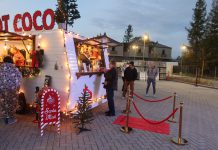Consulting engineers are finished climbing over, inspecting,
measuring and testing Healdsburg’s old Memorial Bridge and are now
putting together new safety and structural numbers and ratings for
a pending city council review on plans to either repair or replace
the 89-year-old steel span over the Russian River.
A consultant’s report and city council review is expected to
take place later this summer.
Among all the numbers now being compiled and analyzed is one big
one that will most influence which option the city might ultimately
choose. And that number is how much Caltrans may be willing to
contribute to the very expensive project.
Historic, visual and environmental sentiments favored by a vocal
and active group of citizens called Save Our Bridge will have to
overcome a Caltrans and federal highway standard of “economic
superiority” that includes a “life cycle cost analysis.”
Renovation of the old bridge has been estimated to cost $9
million while a modern concrete replacement on a new alignment
could cost between $23-$43 million, based on older Caltrans
studies.
A new bridge would be rated with a 75-year lifespan while the
older bridge’s expected lifespan would be much less, according to
preliminary engineer findings.
In March, following much public testimony to save the old
bridge, the city council directed city staff and consultant Omni
Means to do full studies of both renovating the existing bridge and
calculating costs and benefits of a new bridge.
Both alternatives — replace or rehab — will be included
throughout a complete Environmental Impact Review process expected
to last into next year.
“Sometime soon we will want to sit down and have a very frank
conversation with Caltrans and the Federal Highway Administration
(FHWA) before we bring any proposed options forward,” said Mike
Kirn, the city’s Public Works Director. “We will want to know what
proposal they would be willing to support.”
The bridge project is qualified for state and federal funding
under the California Highway Bridge Program. The city-owned bridge
could win as much as 88 percent state and federal funding under the
program, subject to the final consulting engineers’ report and
Caltrans peer review of any proposed project.
“The question could be between doing a project with 88 percent
state and federal funding or a 100 percent locally funded
project,” said Kirn. A local-only project would be “cost
prohibitive” in the current economy, Kirn added.
There are numerous structural, functional and seismic problems
with the old bridge. A 1979 Caltrans report gave the bridge a
“zero” failed grade, finding the bridge could not support its own
weight.
Healdsburg resident Mel Amato, now leading the Save Our Bridge
citizen brigade, found major errors in the earlier Caltrans report
that led to an improved rating that made the bridge worthy of
further study and possible renovation.
During two recent “Open House” meetings led by the bridge
consultants, some 15 proposed projects and alternatives were
defined from public input.
The Omni Means team is now completing cost, environmental,
safety, right-of-way, design and funding capability analyses on all
15 proposals.
A “preferred concept” is supposed to be identified and
recommended by Omni Means and city staff to the city council this
summer.
Doug Ries, of Omni Means, told The Tribune this week that none
of the 15 options has been eliminated so far. The most recent
engineer tests gave the bridge a 42.3 Structural Rating on a scale
of 1 to 100. Any grade below 80 triggers an alarm that a bridge
needs repairs and maintenance. A grade below 50 signals a bridge
may need total replacement.
In response to the most recent bridge studies, Healdsburg’s
Amato told the city he found a series of errors. He said the
bridge’s Structural Rating should be 53.4. Amato believes this
“above 50” rating makes the bridge eligible only for rehabilitation
and not replacement under FHWA funding guidelines.
“Mr. Amato is wrong,” project engineer Todd Goolkasian, of
Cornerstone Structural Engineering, told The Tribune. “I can
unequivocally say the 50 rating is not a hard threshold. Caltrans
must follow federal guidelines that prohibit funding a plan that is
not economically superior.”
Kirn confirmed that Caltrans has recently told the city the
bridge is still potentially eligible for both rehab or
replacement.
Amato this week stood by his independent analysis. “What I read
and reported was plain English, not opinion. The evidence to me is
pretty clear and I believe the engineers have made some mistakes.
Why should we assume they are right this time?”
On other baseline findings, the ongoing engineer and project
analysis has confirmed some hard facts about the old bridge,
focused on its narrow width and aging riverbed foundation.
Healdsburg’s Memorial Bridge is “functionally obsolete” because
it is too narrow. The bridge also needs major seismic earthquake
safety work. The steel truss design, like the recently-collapsed
Bay Bridge, is “fracture critical,” meaning new redundant steel
work and supports would have to be added to improve it’s safety
rating.
Engineer Goolkasian said needed safety and structural repairs
would be a “practical impossibility” without causing severe damage
to the historic bridge’s “fabric” and visual attraction.
Any project to widen the bridge would require cutting it in
half, lengthwise and adding major new peers in the riverbed.
“Ultimately, it’s going to be who’s judgement counts,” said
Goolkasian, referring to the federal funding formula. For the city
to get funding help, “Caltrans must assure the Feds (FHWA) that
they are following the rules.”
Kirn said it is the city’s responsibility to do whatever it can
to make the river crossing more safe. “We are identifying the
weaknesses and problems with our bridge. Caltrans may come up with
one preference, but will that be the best answer for the
community?” Kirn asked.
While some better cost estimates and funding sources may be
known this summer, the answer to what the community wants to do
with their old bridge and what can be afforded won’t be answered
until the completed EIR study and public testimony will concluded
in late 2011.







